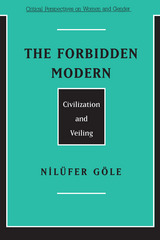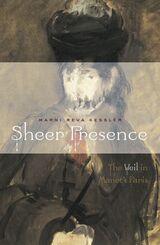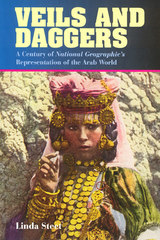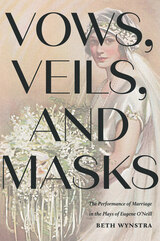4 books about Veils

The Forbidden Modern
Civilization and Veiling
Nilufer Gole
University of Michigan Press, 1997
This book by prominent Turkish scholar Nilüfer Göle examines the complex relationships among modernity, religion, and gender relations in the Middle East. Her focus is on the factors that influence young women pursuing university educations in Turkey to adopt seemingly fundamentalist Islamist traditions, such as veiling, and the complex web of meanings attributed to these gender-separating practices. Veiling, a politicized practice that conceptually forces people to choose between the "modern" and the "backward," provides an insightful way of looking at the contemporary Islam-West conflict, shedding light on the recent rise of Islamist fundamentalism in many countries and providing insight into what is a more complex phenomenon than is commonly portrayed in accounts by Western journalists.
Göle's sociological approach, employing a number of personal interviews, allows for both a detailed case study of these young Turkish women who are turning to the tenets of fundamental Islamist gender codes, and for a broader critique of Eurocentrism and the academic literature regarding the construction of meaning. Both perspectives serve as a springboard for the launching of theoretical innovations into feminist, religious, cultural, and area studies.
"A timely book, whose publication in English will contribute to a variety of scholarly debates. It promises to be provocative and widely read among scholars interested in issues of modernism and identity, women's social movements, the status of women in Islamic societies, and the broader issues of public versus private spheres." --Nilüfer Isvan, State University of New York, Stony Brook
The Forbidden Modern: Civilization and Veiling was originally published as Modern Mahrem by the Turkish publisher Metis and has been translated into French, German, and Spanish. Nilüfer Göle is Professor of Sociology, Bogaziçi University.
Göle's sociological approach, employing a number of personal interviews, allows for both a detailed case study of these young Turkish women who are turning to the tenets of fundamental Islamist gender codes, and for a broader critique of Eurocentrism and the academic literature regarding the construction of meaning. Both perspectives serve as a springboard for the launching of theoretical innovations into feminist, religious, cultural, and area studies.
"A timely book, whose publication in English will contribute to a variety of scholarly debates. It promises to be provocative and widely read among scholars interested in issues of modernism and identity, women's social movements, the status of women in Islamic societies, and the broader issues of public versus private spheres." --Nilüfer Isvan, State University of New York, Stony Brook
The Forbidden Modern: Civilization and Veiling was originally published as Modern Mahrem by the Turkish publisher Metis and has been translated into French, German, and Spanish. Nilüfer Göle is Professor of Sociology, Bogaziçi University.
[more]

Sheer Presence
The Veil in Manet’s Paris
Marni Reva Kessler
University of Minnesota Press, 2006
Tamar’s instrument of seduction in the Hebrew Bible, Penelope’s shroud in Homer’s Odyssey, accessory of brides as well as widows, and hallmark of the religious and the wealthy, the veil has historically been an intriguing signifier. Initially donned in France for liturgical purposes and later for masked balls and as a sun- and windscreen at the seashore, face-covering veils were adopted for fashionable urban use during the reign of Napoleon III. In Sheer Presence, Marni Reva Kessler demonstrates how this ubiquitous garment and its visual representations knot together many of the precepts of Parisian life. Considering the period from the beginning of Napoleon III’s rule in 1852 to 1889, when the Paris Universal Exhibition displayed veiled North African Muslims and other indigenous colonial peoples, Kessler deftly connects the increased presence of the veil on the streets and on canvas to Haussmann’s massive renovation of Paris. The fashion of veil wearing, she argues, was imbricated with broader concerns: fears of dust and disease fueled by Haussmannization and class mixing on the city streets, changes in ideals of youth and beauty, attempts to increase popular support for imperialism, and the development of modernist art practices. A veil was protection for the proper woman from the vices associated with the modern city, preserving—at least on the surface—her femininity and class superiority. Kessler explores these themes with close readings of paintings by Gustave Caillebotte, Edgar Degas, and Edouard Manet—including Manet’s perplexing portraits of artist Berthe Morisot—as well as photographs, images from the popular press, engravings, lithographs, and academic paintings. She also mines French fashion journals, etiquette books, novels, and medical publications for clues to the veil’s complex meanings during the period.Positioning the veil directly at the intersection of feminist, formalist, and social art history, Kessler offers a fresh perspective on period discourses of public health, seduction and sexuality, colonial stereotypes, and, ultimately, an emerging modernity.Marni Reva Kessler is assistant professor of art history at the University of Kansas.
[more]

Veils And Daggers
Linda Steet
Temple University Press, 2000
National Geographic magazine is an American popular culture icon that, since its founding in 1888, has been on a nonstop tour classifying and cataloguing the peoples of the world. With more than ten million subscribers, National Geographic is the third largest magazine in America, following only TV Guide and Reader's Digest. National Geographic has long been a staple of school and public libraries across the country.
In Veils and Daggers, Linda Steet provides a critically insightful and alternative interpretation of National Geographic. Through an analysis of the journal's discourses in Orientalism, patriarchy, and primitivism in the Arab world as well as textual and visual constructions of Arab men and women, Islam, and Arab culture, Veils and Daggers unpacks the ideological perspectives that have guided National Geographic throughout its history. Drawing on cultural, feminist, and postcolonial criticism, Steet generates alternative readings that challenge the magazine's claims to objectivity. In this fascinating journey, it becomes clear that neither text nor image in the magazine can be regarded as natural or self-evident and she artfully demonstrates that the act of representing others "inevitably involves some degree of violence, decontextualization, minaturization, etc." The subject area known as Orientalism, she shows, is a manmade concept that as such must be studied as an integral component of the social, rather than the natural or divine world.
Veils and Daggers repositions and redefines National Geographic as an educational journal. Steet's work is an important and groundbreaking contribution in the area of social construction of knowledge, social foundations of education, popular educational media, and social studies as well as racial identity, ethnicity, gender. Once encountered, readers of National Geographic will never regard it in the same manner again.
In Veils and Daggers, Linda Steet provides a critically insightful and alternative interpretation of National Geographic. Through an analysis of the journal's discourses in Orientalism, patriarchy, and primitivism in the Arab world as well as textual and visual constructions of Arab men and women, Islam, and Arab culture, Veils and Daggers unpacks the ideological perspectives that have guided National Geographic throughout its history. Drawing on cultural, feminist, and postcolonial criticism, Steet generates alternative readings that challenge the magazine's claims to objectivity. In this fascinating journey, it becomes clear that neither text nor image in the magazine can be regarded as natural or self-evident and she artfully demonstrates that the act of representing others "inevitably involves some degree of violence, decontextualization, minaturization, etc." The subject area known as Orientalism, she shows, is a manmade concept that as such must be studied as an integral component of the social, rather than the natural or divine world.
Veils and Daggers repositions and redefines National Geographic as an educational journal. Steet's work is an important and groundbreaking contribution in the area of social construction of knowledge, social foundations of education, popular educational media, and social studies as well as racial identity, ethnicity, gender. Once encountered, readers of National Geographic will never regard it in the same manner again.
[more]

Vows, Veils, and Masks
The Performance of Marriage in the Plays of Eugene O'Neill
Beth Wynstra
University of Iowa Press, 2023
Vows, Veils, and Masks offers a bold and timely approach to the plays of Eugene O’Neill with its attention to the engagements, weddings, and marriages so crucial to the tragic action in O’Neill’s works. Specifically, the book examines the culturally sanctioned traditions and gender roles that underscored marital life in the early twentieth century, and that still haunt and define love and partnership in the modern age.
Weaving in artifacts like advice columns, advertisements, theatrical reviews, and even the lived experiences of the actors who brought O’Neill’s wife characters to life, Beth Wynstra points to new ways of seeing and empathizing with those who are betrothed and new possibilities for reading marriage in literary and dramatic works. She suggests that the various ways women were, and still are, expected to divert from their true ambitions, desires, and selves in the service of appropriate wifely behavior is a detrimental performance and one at the crux of O’Neill’s marital tragedies. This book invites more inclusive and nuanced ways of thinking about the choices married characters must make and the roles they play, both on and off the stage.
Weaving in artifacts like advice columns, advertisements, theatrical reviews, and even the lived experiences of the actors who brought O’Neill’s wife characters to life, Beth Wynstra points to new ways of seeing and empathizing with those who are betrothed and new possibilities for reading marriage in literary and dramatic works. She suggests that the various ways women were, and still are, expected to divert from their true ambitions, desires, and selves in the service of appropriate wifely behavior is a detrimental performance and one at the crux of O’Neill’s marital tragedies. This book invites more inclusive and nuanced ways of thinking about the choices married characters must make and the roles they play, both on and off the stage.
[more]
READERS
Browse our collection.
PUBLISHERS
See BiblioVault's publisher services.
STUDENT SERVICES
Files for college accessibility offices.
UChicago Accessibility Resources
home | accessibility | search | about | contact us
BiblioVault ® 2001 - 2024
The University of Chicago Press









